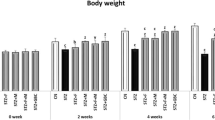Abstract
Studies have shown anti-hyperlipidemic actions of melatonin, with pharmacological doses inducing changes in cholesterol levels. This study was designed to evaluate the effect of melatonin on adriamycin-induced (25mg/kg b.w., i.p.) hyperlipidemia under constant light exposure. Melatonin was injected i.p. (1000 μg/kg b.w./day). Triglycerides, total cholesterol, high-density lipoprotein cholesterol, light-density lipoprotein cholesterol, non-proteic nitrogen compounds (urea and creatinine levels), total protein in serum, proteins eliminated in the urine and melatonin levels in serum and kidney were determined. Results show a decrease in melatonin levels induced by both adriamycin and constant light. Likewise, adriamycin induced significant increases in triglycerides, total cholesterol and light-density lipoprotein cholesterol, and lowered high-density lipoprotein cholesterol levels. Constant light exposure also prompted an increase in LDL-c levels and a decrease in HDL-c values, and intensified the effects of adriamycin on these two lipoproteins. All changes induced by adriamycin and constant light were reverted toward normality by melatonin administration.
Resumen
Se ha descrito que la melatonina presenta acción antihiperlipidémica y que, a dosis farmacológica, modifica los niveles de colesterol. El objetivo del presente trabajo consiste en evaluar el efecto de la melatonina sobre la hiperlipidemia inducida por adriamicina (25 mg/kg peso corporal, i.p.), bajo iluminación constante. La melatonina se inyecta por vía intraperitoneal, 100 mg/kg peso corporal. Se determinan los niveles séricos de triglicéridos, colesterol total, HDL-colesterol, LDL-colesterol, urea y creatinina, las proteínas eliminadas en orina y los niveles de melatonina en suero y en riñón. Los resultados muestran que por efecto conjunto de la adriamicina y la iluminación constante se observa disminución de la melatonina. La adriamicina incrementa los niveles de triglicéridos, colesterol total y LDL-colesterol y disminuye los de HDL-colesterol. La iluminación constante también modifica en el mismo sentido los niveles de HDL y LDL e intensifica los efectos de la adriamicina sobre ambas lipoproteinas. Todos los cambios inducidos por adriamicina y por iluminación constante revierten hacia la normalidad por administración de melatonina.
Similar content being viewed by others
References
Armstrong, S. (1989):Pineal Res. Rev.,7, 158–202.
Beretazolli, C., Chieli, T., Ricevuti, G. and Solicia, E. (1972):Toxicol. Appl. Pharmacol.,21, 287–301.
Bertani, T., Poggi, A., Pozzoni, R., Delaini, F., Sacchi, G., Thoua, Y., Mecca, G., Remuzzi, G. and Donatti, M. B. (1982):Lab. Invest.,46, 16–23.
Canepa, A., Ghiggeri, G. M., Ginevri, F., Trivelli, A., Perfumo, F. and Gusmano, R. (1992):Nephon,60, 342–348.
Ciaccio, M., Valenza, M., Tesoriere, L., Bongiorno, A., Albiero, R. and Livrea, M. A. (1993):Arch. Biochem. Biophys.,302, 105–108.
Chan, T. Y. and Tang, P. L. (1995):Endocr. Res.,21, 681–696.
Fajardo, L. F., Eltthringham, J., Stewart, J. and Kaluber, M. (1980):Lab. Invest.,43, 242–253.
Hoyos, M., Guerrero, J. M., Pérez-Cano, R., Olivan, J., Fabiani, F., Garcia-Perganeda, A. and Osuna, C. (2000):J. Pineal Res.,28, 150–155.
Mimic-Oka, J., Simic, T., Djucanovik, L., Reljic, Z. and Davicevic, Z. (1999):Clin. Nephron,51, 233–241.
Montilla, P., Túnez, I., Muñoz, M. C., Gascón, F. and Soria, J. V. (1998):J. Pineal Res.,25, 86–93.
Montilla, P., Túnez, I., Muñoz, M. C., López, A. and Soria, V. (1997):Nephron,76, 345–349.
Mori, N., Aoyama, H., Murase, T. and Mori, W. (1989):Acta Pathol. Jpn.,39, 613–618.
Okuda, S., Oh, Y., Tsuruda, H., Onoyuma, K., Fujimi, S. and Fujishima, M. (1986):Kidney Int.,29, 502–510.
Reiter, R. J. (1993):Experientia,49, 654–664.
Rindone, J. P. and Achacoso, R. (1997):Am. J. Ther.,4, 409–411.
Sechi, L. A., Ceriello, A., Griffin, C. A., Catena, C., Amstad, P., Schambelan, M. and Bartoli, E. (1997):Diabetologia,40, 23–29.
Suzuki, Y., Ohnuma, T. and Goldsmith, M. A. (1978):Fed. Proc. 37, 320.
Author information
Authors and Affiliations
Corresponding author
Rights and permissions
About this article
Cite this article
Túnez, I., Muñoz, M.C., Feijoo-López, M. et al. Effect of melatonin on hyperlipidemic nephropathy under constant light exposure. J. Physiol. Biochem. 58, 109–114 (2002). https://doi.org/10.1007/BF03179846
Received:
Issue Date:
DOI: https://doi.org/10.1007/BF03179846




